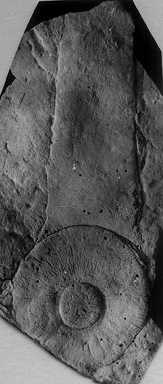|
|
Cyclomedusa is the most common element in the Ediacaran fauna, and was
originally considered to be a fossil medusa or jellyfish. However, there were
great difficulties in explaining how so many jellyfish managed to get covered by
sand when they normally live in the water column and not on the bottom. It was
realised that they actually represent the anchoring holdfasts of colonial, soft
octocorals. This explains why they are so common - because they were already
buried, and most of the 'species' are now considered to be due to differing
preservation. This specimen is typical, showing various radial and concentric
patters which are now though to represent the wrinkling of the outer layer, or
internal tissues such as muscles. Scale = 1 cm. |
|
|
This is a large specimen photographed in the field. The three dimentional
nature of the fossil can be seen by its overlapping of a thin film of sand
(bottom left) which inturn overlaps the main bedding plane which has most of the
disc on it. Remember this is a view of the bottom of the bed, thus the fossil
is projecting outward (downward) into the underlying bed. The faint image of
the stem can be seen running away from the disc at the 3 o'clock position.
Compass = 11 cm in length. |
|
|
This is an even larger specimen (approx. 23 cm in diameter). This specimen
shows the faint image of the pedunculus (center of disc, running out towards the
4 o'clock position. The pedunculus is the bottom part of modern sea pens which
is used to burrow into the sediment and acts as part of the anchoring system.
Scale = 1 cm. |
 |
Charniodiscus. Just to show that they are, in fact, holdfasts, this
specimen has the stem still attached. Length of speciman 22 cms. |
